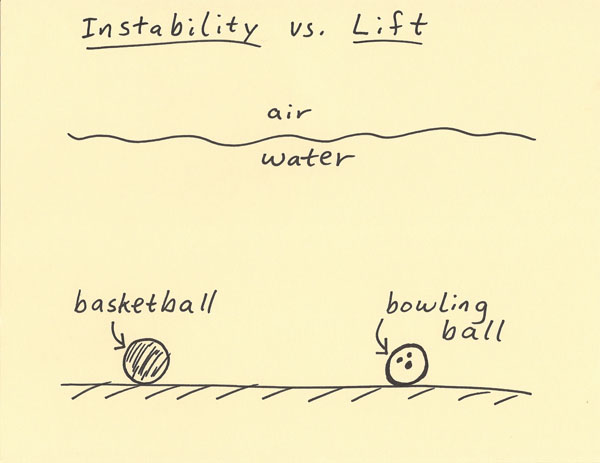
In meteorology, instability and lift are fundamentally different terms. This writing will define and compare / contrast these two very important terms. Lift in meteorology is the forced lifting of air. By forced it means there is an agent that is making the air move in the vertical. Examples of rising lifting agents are fronts, low level warm air advection, upper level divergence, flow over a terrain barrier such as a mountain, and low level convergence. In the diagram below, the bowling ball on the right side of the diagram will act as our analogy for lift. The bowling ball is sitting on the bottom of the swimming pool. Since this bowling ball is round and denser than water it will just sit on the bottom of the pool. In order for the bowling ball to rise it will have to be force lifted. It will not rise on its own. An agent will need to be present to lift the bowling ball out of the water such as a person forcing it up to the surface. Instability (and particularly instability release) in meteorology is a situation, that under the right conditions, air will rise on its own by no longer needing an agent to force lift the air. Instability is important for thunderstorm development and for convective clouds. Without instability, heavy precipitation would be less common and severe weather would be less common. Rising air from instability release can rise much faster than by forced lifting. Instability release can produce heavy rain and thunderstorms. Just because instability is present does not mean that a convective rising of air will occur. Typically there needs to be an agent to give air enough of a nudge upwards so that the air will find itself in a situation where it can convectively rise on its own. When instability is present but no convective elements are occurring, this situation is referred to as the atmosphere being “capped”. Thus, often lift and instability need to work in tandem in order for convective elements to fire off. Basically, the lift is initiating the rising motion up to an elevation high enough in which the parcel of air will find itself less dense than the surrounding environment. Once in this environment, the parcel can rise on its own by positive buoyancy (instability release). The diagram below with the basketball full of air on the bottom left side of the swimming pool will act as our analogy for instability and instability release. The basketball with air is much less dense than the surrounding pool water. Thus, this basketball parcel is already in a situation where it will explosively rise due to positive buoyancy. Once the basketball is let go from the bottom of the pool it will rise on its own without any agent to make it rise. This is instability release.  |